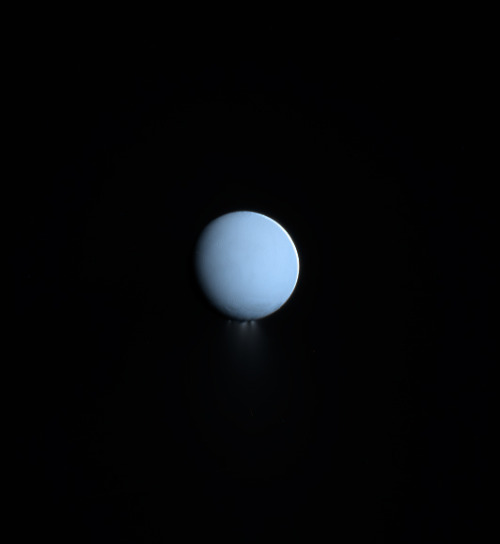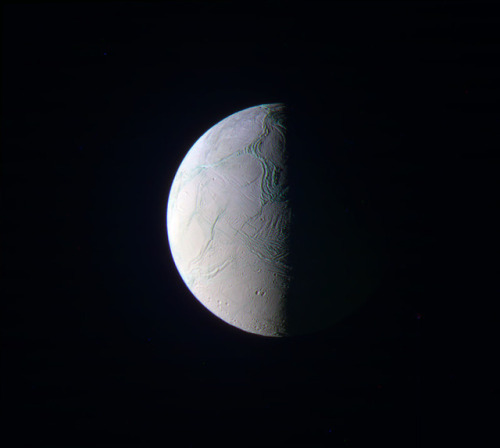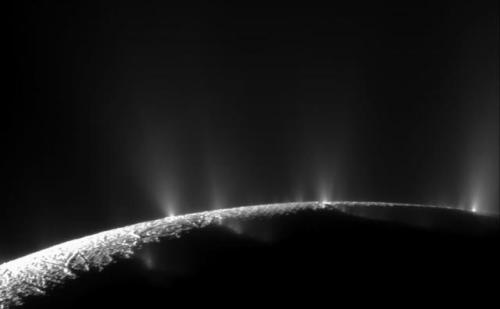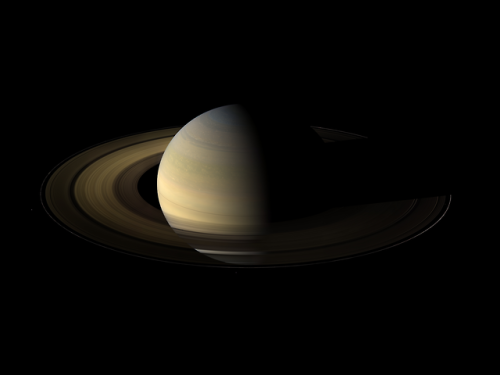Picture Of The Day - November 16, 2018

Picture of the day - November 16, 2018
An Earth-Moon analog.
More Posts from Sharkspaceengine and Others

Picture of the Day - February 11, 2019 (Late post)
Blue ice giant with blue rings.









Enceladus
Enceladus is one of the major inner moons of Saturn along with Dione, Tethys, and Mimas. It orbits Saturn at a distance of 148,000 miles (238,000 km), falling between the orbits of Mimas and Tethys. It is tidally locked with Saturn, keeping the same face toward the planet. It completes one orbit every 32.9 hours within the densest part of Saturn’s E Ring, the outermost of its major rings, and is its main source.
Enceladus is, like many moons in the extensive systems of the giant planets, trapped in an orbital resonance. Its resonance with Dione excites its orbital eccentricity, which is damped by tidal forces, tidally heating its interior, and possibly driving the geological activity.
Enceladus is Saturn’s sixth largest moon, only 157 miles (252 km) in mean radius, but it’s one of the most scientifically compelling bodies in our solar system. Hydrothermal vents spew water vapor and ice particles from an underground ocean beneath the icy crust of Enceladus. This plume of material includes organic compounds, volatile gases, carbon dioxide, carbon monoxide, salts and silica.
With its global ocean, unique chemistry and internal heat, Enceladus has become a promising lead in our search for worlds where life could exist.

In 2005, Cassini’s multiple instruments discovered that this icy outpost is gushing water vapor geysers out to a distance of three times the radius of Enceladus. The icy water particles are roughly one ten-thousandth of an inch, or about the width of a human hair. The particles and gas escape the surface at jet speed at approximately 800 miles per hour (400 meters per second). The eruptions appear to be continuous, refreshing the surface and generating an enormous halo of fine ice dust around Enceladus, which supplies material to one of Saturn’s rings, the E-ring.
Several gases, including water vapor, carbon dioxide, methane, perhaps a little ammonia and either carbon monoxide or nitrogen gas make up the gaseous envelope of the plume.
Read more at: solarsystem.nasa.gov
Image credit: NASA/JPL/Cassini & Kevin Gill
Ten interesting facts about Saturn
Saturn is sometimes called “The Jewel of the Solar System.” It is a planet that is nothing like our own. Humans have been gazing up at Saturn for a long time. They have been wondering about it for thousands of years.
Here are some fun facts about the Ringed Planet.

Saturn is huge. It is the second largest planet in our Solar System. Jupiter is the only planet that is bigger.

The rings are huge but thin. The main rings could almost go from Earth to the moon. Yet, they are less than a kilometer thick.

Four spacecraft have visited Saturn: Pioneer 11, Voyager 1 and 2, and the Cassini-Huygens mission have all studied the planet.

Saturn has oval-shaped storms similar to Jupiter’s: The region around its north pole has a hexagonal-shaped pattern of clouds. Scientists think this may be a wave pattern in the upper clouds. The planet also has a vortex over its south pole that resembles a hurricane-like storm.

Saturn is made mostly of hydrogen and helium: It exists in layers that get denser farther into the planet. Eventually, deep inside, the hydrogen becomes metallic. At the core lies a hot interior. (click the image for a better resolution).

Saturn has 62 moons: Some of these are large, like Titan, the second largest moon in the Solar System. But most are tiny – just a few km across, and they have no official names. In fact, the last few were discovered by NASA’s Cassini orbiter just a few years ago. More will probably be discovered in the coming years.

Saturn orbits the Sun once every 29.4 Earth years: Its slow movement against the backdrop of stars earned it the nickname of “Lubadsagush” from the ancient Assyrians. The name means “oldest of the old”.

In Saturn there is aurora: Photographic composition made by the Hubble Space Telescope showing the occurrence of aurora in the southern hemisphere of Saturn at intervals of two days.The aurora is visible only in the ultraviolet.

Saturn spins on its axis very fast. A day on Saturn is 10 hours and 14 minutes.

You can see Saturn with your own eyes: Saturn appears as one of the 5 planets visible with the unaided eye. If Saturn is in the sky at night, you can head outside and see it. To see the rings and the ball of the planet itself, you’ll want to peer through a telescope. But you can amaze your friends and family by pointing out that bright star in the sky, and let them know they’re looking at Saturn.
sources: nasa.gov, universetoday.com and solarsystem.nasa.gov

Picture of the day 2 - November 22, 2019
Densely packed sky of an airless world within the M59 galaxy. The planet’s dark rings obscure some of the stars.

Picture of the day - February 14, 2019 (Late Post).
A dark nebula obscures the galaxy.

Picture of the day - December 18, 2018
Polar vortex over the northern pole of Insight A-II










Triangulum Log - Vernier System.
We’ve gone deeper into the Triangulum System and come across this binary system. The system consists of a hot F-Type Star 3.1 times brighter than our sun, orbited by a much less luminous K-Type Star only a fifth the brightness of our sun. The system has 6 planet’s including the most earth-like planet I’ve come across yet.
The Inner-most planet is a warm Ice-Giant with 53 earth masses and atmosphere temperatures of 378 K or 221 °F, orbiting the common center of mass of the two suns at a distance of 0.78 AU. The atmosphere of the planet is extremely turbulent under the intense sun-light. Wind speeds reach up to 1,100 kilometers per hour and cyclonic systems churn across the equator.
The second planet is Earth-like planet roughly 0.20 Earth masses, and radius 0.60 times that of Earth. Liquid water oceans cover a small portion of the surface. The planet is more desert-like than Earth, with water covering less than 15% of the surface. The atmosphere has only 0.15 atmosphere’s of pressure and has an unusual composition. Carbon dioxide comprises 84.4% of the atmosphere mixed with 13.1% Acetylene and 1.3% sulfur dioxide. The acetylene is stable in the atmosphere due to there being no oxygen; however, ultraviolet light natural breaks the compound down, forming Tholins in the atmosphere, giving the atmosphere a thick haze. Surface temperatures average 320 K or 116 °F. The planet has no polar ice-caps and orbits 1.25 AU from the stars. Several asteroid-sized moons orbit the planet along with larger rounded satellite that has a radios of 374 km.
High Resolution Pictures.
Picture 1 - Two Suns and a Giant
Picture 2 - Inner-Most Ice Giant
Picture 3 - White and Orange Suns over stormy skies
Picture 4 - Jewel of the System - Earth-like World
Picture 5 - Desert-world with some seas
Picture 6 - Hazy Atmosphere
Picture 7 - Planet’s Surface
Picture 8 - Different Layers of the atmosphere.
Picture 9 - Planet’s small moon.
Picture 10 - Sun’s setting on the lunar surface.







Oculus System - Post 3 (Cratered Wasteland)
The system’s third planet is a nearly airless Mars-sized world, heavily cratered world. The planet orbits 1.19 AU from the sun, has a mass of just 8.6% that of Earth and roughly half of Earth’s diameter. A tenuous carbon dioxide atmosphere clings to the surface with a surface press of just 1/100,000th that of Earth. Surface temperatures can reach the boiling point of water during the day, and fall nearly -300 °F at night.
High Resolution Pics
Picture 1 - Mercury-like planet
Picture 2 - Two small satellites
Picture 3 - A view from a moon
Picture 4 - Setting Sun.
Picture 5 - Broken Crater
Picture 6 - From just 10 km above the surface.
Picture 7 - The Surface

Picture of the day - November 27, 2018
Red and dusty desert world similar to Mars but with a much thicker atmosphere, glowing red under the light of a red sun.

Saturn’s equinox in 2009 taken by Cassini spacecraft
Credit: NASA/JPL
My Space Engine Adventures, also any space related topic or news. www.spaceengine.org to download space engine. The game is free by the way. Please feel free to ask me anything, provide suggestions on systems to visit or post any space related topic.Check out my other blog https://bunsandsharks.tumblr.com for rabbit and shark blog.
294 posts